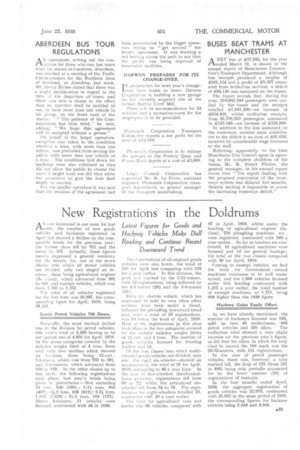New Registrations in the Doldrums
Page 43

If you've noticed an error in this article please click here to report it so we can fix it.
Latest Figures for Goods and Had Vehicles Make Dull Reading and Continue Recent Downward Trend
A s was intimated in our issue for last I-1,week, the number of new goods vehicles and hackneys registered in April last showed a decline on the comparable totals for the previous year ; the former class fell by 751 and the latter by 157. Actually, these figures merely expressed a general tendency for the month, for, out of the seven classes into which all motor vehicles are divided, only two staged an increase, these being agricultural engines (Si. class), which advanced from 591 to .828, Elnd exempt vehicles, which rose from 1,355 to 1,751.
The total of all vehicles registered for the lirst time was 38,897, the corresponding figure for April, 1938, being 39,:157.
Goods Petrol Vehicles 700 Down.
Naturally, the most marked decline was in the division for petrol vehicles, this year's total of 4,268 having to be set against one of 4,958 for April. 1938. In the seven categories covered by the unladen weight limit of 4 tons, there were only two sections which showed tin iricrease, these being 12-ewt.1-toriners, which rose from 793 to 891, and 8-4-tanners, which advanced from 108 to 41.9. In the other classes up to this limit, the following registrations took place, last year's totals being given in parentheses :—Not exceeding 12 ewt., 646 (808) ; 1-14 tons, 403 (497); 11-2 tons, 628 (812); 2-21 tons, 1,3S45 (1,629) ; 2i-3 tons, 164 (175). Above 4-tonners, 31 vehicles were licensed, contrasted with 46 in 1938. The registrations of oil-engined goods vehicles were also lower, the total of 120 for April last comparing with 1.52 for a year earlier, In this division, the pent: was reached by the 2-21-tonner, with =r2 registrations, being followed by the 4tanner (26) and the 3-4-tonner (21).
Even the electric vehicle, which has continued to hold its own when other sections have been under a cloud, followed the prevailing downward trend and, with a total of 53 registrations, was 10 below the level of April, 1938. Most of the registrations t this class took place in the two categories covered by the outside unladen weight limits of 12 cwt. and 2 tons. The number of goods vehicles licensed for drawing trailers was 12.
Of the four classes into which multiwhechei goads vehicles are divided, only one the rigid six-wheeler—showed an improvemeet, the total of 36 for April, 1938, advancing to 46 a year later. In the case of five-wheeters (mechanicalhorse pattrrn), registrations fell from 99 to 72, whilst the articulated sixwhether full from 34 to 19. The registratinns tor eight-wheelers totalled 23, contrasted with 28 a year earlier.
The foral for agricultural vans and lorries was 66 vehicles, compared with 87 in April, 1938, whilst under the heading of agricultural engines(5s. class), 758 ploughing machines, etc., were registered contrasted with 546 a year earlier. So far as tractors are concerned, 15 agricultural machines were licensed and 14 for general haulage ; the total of the two classes compared with 30 for April, 1998.
Coming to exempt vehicles, we find the total for Government owned machines continues to be well maintained, and the 1,608 vehicles licensed under this heading contrasted with 1,217 a year earlier, the total number of exempt machines, at 1,751, being 396 higher than the 1938 figure.
Hackney Gains Easily Offset.
As we have already mentioned, the number of hackneys licensed was 796, split up into 40 trolleybuses, 406 petrol vehicles and 350 oilers. The trolleybus total showed a very slight increase on the previous year's figure, as did that for oilers, in which the only class to exceed the 100 mark was the 26-32-seaters, with 131 registrations.
In the case of petrol passenger vehicles, there was, however, a very marked fall, the drop of 175 (from 581 to 40(3) being only partially accounted for by the lower number (58) of registrations of taxicabs.
In the four months ended April, 1939, the aggregate registration of goods vehicles was 22,976, contrasted with 25,633 in the same period of 1938, the corresponding figures for hackney vehicles being 2,843 and 9,062.












































































